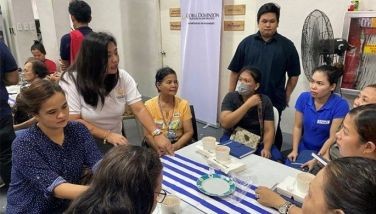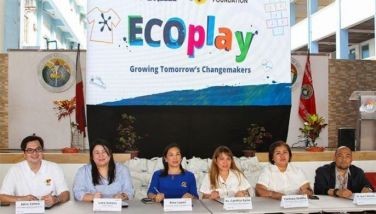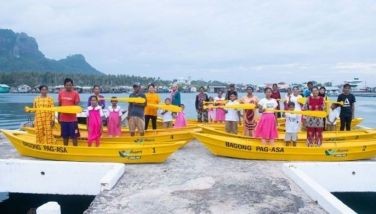Lest we lose our Edens

On the eve of Philippine Environment Month, we borrow our title from Browning and yield this space to my brother Prof. Macky Maceda, sustainability director of Enderun Colleges, with his thoughts on the family’s love for nature.
My brothers and I discovered nature and wildlife during our childhood years at the Sampaguita Pictures compound in Quezon City. Our maternal grandmother, Azucena “Mama Nene” Vera-Perez, was a certified plantita who loved bougainvilleas, orchids and all kinds of flowers, while our grandfather, Dr. Jose “Daddy Pinggot” Perez, was into fruit trees, foliage plants, water features and rockscapes. Together they created a magical urban forest that beautified the property, provided habitat for a wide variety of insects, birds and aquatic life and served as a living science lab for curious children like us.
Towering over the property were old santol trees (as the story goes, our grandparents planted one for each of their seven children) and large mango trees, including the productive “Indian mango” tree that bore its fruit within arm’s reach at the terasa. Refreshing santolada and mangolada drinks were prepared for all, often using fruit that we would sungkit or shoot down with slingshots. There was also an avocado tree near the kitchen, kaimito and macopa trees behind the house, and camachile and pili trees above Daddy Pinggot’s office.
Older Sampaguita stars would remember the lone rubber tree in the center of the garden that served as a backdrop for many movie classics. My older brothers recall making rubber balls from the tree sap. All types of palms, ferns and philodendrons thrived under the Sampaguita canopy of trees. We also saw plants used to heal a variety of ailments.
There were butterflies and moths of all colors and sizes, including the elusive giant Mariposa (Atlas moth). One of Mama Nene’s favorite stories was about a large black-winged, red-bodied butterfly that visited her regularly. Naturally, we saw caterpillars of all types, especially those hairy higads which would turn into cocoons before emerging as moths. We enjoyed chasing large dragonflies, tutubing kalabaw, and slender damselflies called tutubing karayom.
There were fireflies at night, some of which my older brothers caught in glass jars; flying salagubangs, Goliath beetles and the ever-present cicadas singing in unison at dusk. Also, spiders – including the smaller ones we’d collect for play-fights on sticks, the larger ones which spun the most intricate webs, and the thin ones that skipped across the water surface in the ponds.
Birds took shelter and foraged throughout the property: mayas, tarats, bato-bato and the occasional lawin overhead. Bats swirled around at night, feeding on the fruit-laden trees. Reptiles roamed freely, including bayawaks, bubulis, turtles and snakes. I remember my first encounter with a foot-long garter snake that crossed my path – it was more scared of me than I was scared of it – and we both backed away with respect for each other. There were frogs and toads, with the fountain in the middle of the circular driveway serving as home base. At the ponds around Daddy Pinggot’s office, my brother Erwin would catch the thumb-sized shiny frogs we would use as bait for dalags with our makeshift fishing poles.
Bisecting the property was a vibrant creek that we could handily access by descending down the foundations of the foot bridge connecting both sides. There we collected guppies, gouramis and orange dalag fingerlings near the banks while the older men waded through the water for the large hito, dalag and martiniko using traditional basket traps made of bamboo. We remember seeing and marveling at the beauty of a bayawak for the first time during one of those fishing sessions.
Our nature playground wasn’t limited to the Sampaguita compound. Mama Nene was the executive director of Nayong Filipino at the time and she would take us there on weekends. Led by our Uncle Cocoy, my brothers and I loved to explore the wilderness areas of the park, such as the creeks where we rode small canoes and fished for tilapia. The environment back then was truly clean and green.
On the paternal side, our Dad and our Lola Corazon Maceda would also take us on trips to the beach side ancestral home in San Esteban, Ilocos Sur. There we played with starfish, seaweed and hermit crabs, and our family enjoyed the culinary delicacies of that area – lots of fresh seafood, all-you-can-eat sea urchins (Ernest still bears the scars of urchin spines in his foot), Lola’s favorite seaweed arorosip and the best dinengdeng.
Our love for nature continues to this day. Our mother Marichu was renowned for her floral creations. Big brother Manny and Lyra grow all kinds of fruits and vegetables around the house. Brother Ernest and Rica are propagating a mini Sampaguita gardens homage in their backyard. Brother Erwin is a master diver who sidelines as a landscaper. Brother Edward took on fishponds as a hobby. I also became a landscaper at some point in my career, specializing in butterfly gardens. During my stint with the Fil-Estate Group, our environmental conservation efforts led to the certification of the Southwoods and Forest Hills golf courses as Audubon Cooperative Sanctuaries.
Armed with a degree in Environmental Engineering & Science and after a long career in the corporate business world, I now find myself in the academe as a sustainability educator. Without a doubt, the most important lesson I share with students is to reconnect with and rediscover their love for nature and, if they have younger siblings or cousins, help them to connect with nature as early as possible.
There are many ways to do this, such as visiting the village park, taking trips to nearby nature destinations, watching ecologically-themed movies on Netflix or Youtube, avoiding and speaking out against the consumption and trade of exotic wildlife and growing your own plants and vegetables at home. Even a potted plant in itself is a rich ecosystem that you can use to teach younger children about the wonders of nature, especially if we encourage them to take care of the plant.
It’s quite sad that many of our kids are growing up in a world with damaged ecosystems and dwindling wildlife but, with proper guidance and encouragement, we can hope that some of them will become passionate champions for wildlife conservation and habitat restoration.
- Latest
- Trending






















